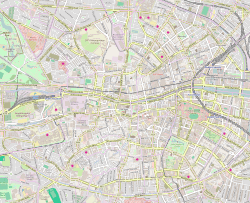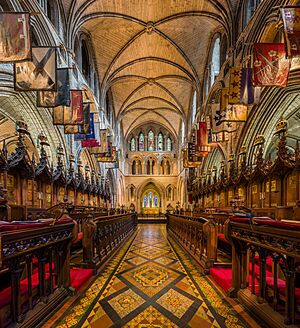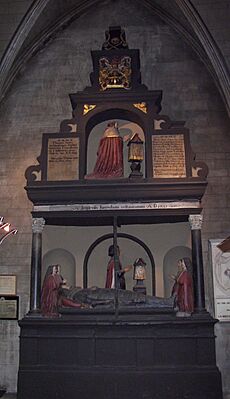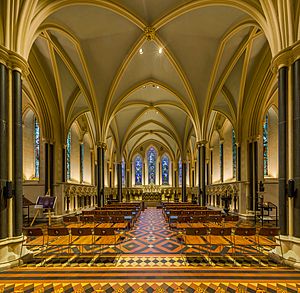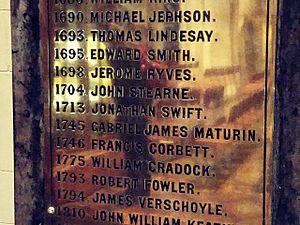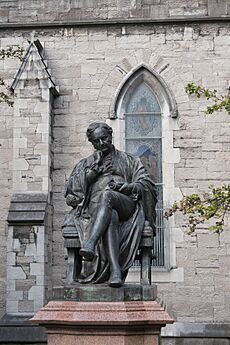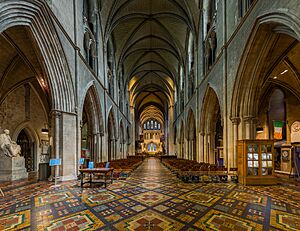St Patrick's Cathedral, Dublin facts for kids
Quick facts for kids St Patrick's Cathedral, Dublin |
|
|---|---|
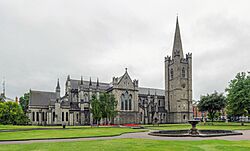 |
|
| 53°20′22″N 6°16′17″W / 53.33944°N 6.27139°W | |
| Location | St Patrick's Close, Patrick Street, Dublin 8 |
| Country | Republic of Ireland |
| Language(s) | English |
| Denomination | Church of Ireland |
| Previous denomination | Roman Catholic 1191–1540) |
| Churchmanship | Broad Church |
| History | |
| Founded | 1191 |
| Founder(s) | John Comyn |
| Dedication | Saint Patrick |
| Architecture | |
| Style | Gothic |
| Specifications | |
| Length | 287 ft (87 m) (internal) 300 ft (91 m) (external) |
| Width | 160 ft (49 m) (across transepts) |
| Nave width | 68 ft (21 m) |
| Floor area | 21,300 sq ft (1,980 m2) |
| Number of spires | 1 |
| Spire height | 225 ft (69 m) |
| Administration | |
| Diocese | Dublin and Glendalough |
| Province | Dublin |
Saint Patrick's Cathedral (which means Ard-Eaglais Naomh Pádraig in Irish) is a very old and important church in Dublin, Ireland. It was first built in 1191 as a Roman Catholic cathedral. Today, it is the national cathedral for the Church of Ireland. Dublin has another important church, Christ Church Cathedral, which is the local cathedral for the Diocese of Dublin and Glendalough.
Contents
Why is St Patrick's Cathedral Special?
St Patrick's is unique because it is not the main church for the local bishop. The Archbishop of Dublin has his main church at Christ Church Cathedral. Since 1870, St Patrick's has been known as the national cathedral for all of Ireland. Its leaders, called chapter members, come from all 12 areas (dioceses) of the Church of Ireland.
The main leader of the cathedral is called the dean. This job has existed since 1219. The most famous person to hold this job was Jonathan Swift, who wrote Gulliver's Travels.
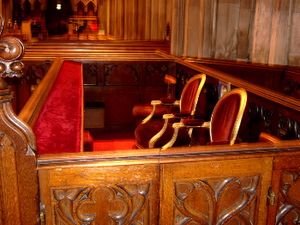
It is very unusual for a city to have two cathedrals. For a long time, there was some disagreement about which church was more important. This was settled in 1300 with an agreement called the Pacis Compositio. This agreement said:
- The Archbishop of Dublin would be officially welcomed at Christ Church.
- Christ Church was the older and more important cathedral for the local area.
- Christ Church would keep special items from dead Archbishops.
- Archbishops would be buried in each cathedral in turn.
- Special oil for the diocese would be made at Christ Church.
- Both cathedrals would work together and share their freedoms equally.
For many centuries, both cathedrals worked side-by-side. Later, when the Church of Ireland changed, Christ Church became the main cathedral for Dublin. St Patrick's became the national cathedral for the whole country.
History of St Patrick's Cathedral
Early Years and Building the Cathedral
In 1192, John Comyn, who was the first Anglo-Norman Archbishop of Dublin, made one of Dublin's churches a "collegiate church." This meant it had a group of clergy focused on worship and learning. This church was dedicated to Saint Patrick. It was built near a holy well and between two parts of the River Poddle. The church was officially opened on March 17, 1191.
A special letter from the Pope, called a papal bull, confirmed Comyn's plans. Over time, many buildings grew up around the cathedral. The current building, which is the largest church in Ireland, was mostly built between 1191 and 1270. Not much of the very first work remains today.
Much of the building work was managed by Henry of London. He was a friend of the King of England and helped build Dublin's city walls and Dublin Castle. In 1225, King Henry III allowed money to be collected across Ireland to help rebuild the church. The work was done in the Early English Gothic style. A special chapel, called the Lady Chapel, was added around 1270.
In 1311, a university was started here, but it did not last long. From the mid-1300s, part of the church was used as a local parish church. The tower and west part of the church were rebuilt between 1362 and 1370 after a fire.
The cathedral has always had problems with water leaking in and floods. This is because it is built near branches of the River Poddle. This means there has never been a basement or crypt area.
Changes During the Reformation
After the English Reformation, which was a time of big religious change, St Patrick's became an Anglican church (part of the Church of Ireland). In the 1530s, some parts of the cathedral were damaged by soldiers. In 1544, part of the church even collapsed.
Under King Edward VI, St Patrick's Cathedral was closed as a cathedral and became just a parish church. The King used part of the building as a courthouse. However, in 1555, King Philip and Queen Mary brought back the cathedral's special rights and started its repair.
The 1600s and Cromwell
By the early 1600s, parts of the cathedral were in ruins. There were also regular floods. In 1620, a judge named Luke Gernon wrote about how badly kept the cathedral was.
When Oliver Cromwell was in Dublin, he used the main part of the cathedral to stable his horses. This showed his dislike for the Anglican church, which he linked to Roman Catholicism.
After the monarchy was restored in 1660, repairs began. In 1666, the cathedral allowed French-speaking Huguenots (Protestants who fled France) to use the Lady Chapel. This chapel was known as L'Eglise Française de St Patrick until 1816.
In 1668, the roof was replaced. Buttresses (supports) were added, and a new window was put in the west end. In the 1680s, the choir was reformed. For a short time during a war in 1688–90, James II and his Catholic followers took over St Patrick's. But after the Protestant Williamites won the war, the cathedral was returned to Anglican control in 1690.
The 1700s and Jonathan Swift
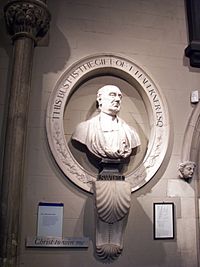
The famous writer Jonathan Swift, who wrote Gulliver's Travels, was the dean of the cathedral from 1713 to 1745. Many of his well-known speeches and writings were given during his time as dean.
You can see his grave and a special message about him in the cathedral. His friend Stella is also buried there. Swift cared a lot about the building and its services. He also helped people in need, setting up a home for poor women and a hospital.
The Choir School, which started in 1432, provided many singers for the first performance of Handel's famous music piece, Messiah, in 1742. In 1749, the cathedral's tall spire was added. It is still a famous landmark in Dublin today.
In 1792, church services had to stop for a while because the south wall was leaning badly.
Knights of St Patrick
From 1783 to 1871, the cathedral was the chapel for the Order of Saint Patrick. These were special knights. When the Church of Ireland became independent in 1871, the ceremonies moved to Dublin Castle. The colorful flags of these knights still hang in the choir area today.
The 1800s and Major Restoration
By 1805, parts of the cathedral were in very bad shape. Urgent repairs were needed. In the mid-1800s, an old Celtic cross was found buried near the cathedral. People think it might have marked the spot of the old holy well.
A huge restoration project happened between 1860 and 1865. It was paid for by Benjamin Guinness, a famous brewer. He was worried the cathedral would collapse. Because of this big rebuild, much of what you see today looks Victorian, not medieval. Sadly, few records were kept of this work.
Even though the rebuilding saved the cathedral, it is hard to know how much of the building is truly old medieval work and how much was rebuilt in the Victorian style. A statue of Sir Benjamin Guinness stands outside the south door. His son, Arthur, gave a stained glass window. In 1901, another son, Edward, created the nearby "St Patrick's Park" and gave new bells to the cathedral.
In 1871, the Church of Ireland became independent. It was decided that Christ Church would be the main cathedral for Dublin. St Patrick's would become the national cathedral for all of Ireland.
St Patrick's Cathedral Today
The cathedral is a place for many important national events. Ireland's Remembrance Day ceremonies happen here every November. The President of Ireland often attends. The Christmas carol service, held twice in December, is a popular event in Dublin.
On Saturdays in autumn, the cathedral hosts graduation ceremonies for Technological University Dublin.
The funerals of two Irish presidents, Douglas Hyde and Erskine Childers, took place here. In 2006, a group of Afghan migrants seeking asylum stayed in the cathedral for several days. They left peacefully after discussions.
How the Cathedral is Run
Leaders of the Cathedral
The cathedral is led by the dean. It is also governed by a group called the chapter. This group started with 13 members and now has up to 28. Their roles come from the original charter of 1191.
The dean is in charge of the clergy and services. Other matters are decided by the whole chapter. The members of the chapter represent the entire Church of Ireland. They hold special positions or are called "prebendaries."
Current Leaders
- Dean: The current dean is the Very Revd William Morton.
- Precentor: The current precentor is the Revd Peter Campion.
- Chancellor: The current chancellor is the Very Revd Niall Sloane.
- Treasurer: The current treasurer is A.H.N. McKinley.
There are many other special roles, called prebends, held by different clergy members. These roles have long histories, some going back to the cathedral's founding in 1191.
Ecumenical Canons
Since 2007, St Patrick's has had two special "ecumenical canons." One is Presbyterian and one is Roman Catholic. They can be invited by the dean to lead prayers, read from the Bible, and help with services. They also take part in chapter meetings.
What to See at the Cathedral
The cathedral does not get money from the government. It welcomes everyone. There is a quiet chapel for prayer. Visitors who want to look around usually pay a small fee. In 2006, about 300,000 people visited each year.
A famous story says that the phrase "chancing your arm" (meaning to take a risk) started here. In 1492, The 8th Earl of Kildare cut a hole in a door to shake hands with his enemy, the Earl of Ormond. This was to make peace. You can still see this door today.
After the Easter Rising, soldiers gathered outside St Patrick's. They then marched to Richmond Barracks, where their leaders were sentenced to death.
Burials at the Cathedral
More than 500 people are buried at the cathedral, both inside and in the graveyard. Some famous people buried here include:
- Jonathan Swift, the writer and former dean.
- Esther Johnson ("Stella"), his close friend.
- Many Archbishops of Dublin from different times.
- Sir Benjamin Lee Guinness, who paid for the major restoration.
Choir School and Grammar School
The choir school is still active. It used to be only for boys, but now girls can join too. A Girls' Choir started in 2000. Many of the choir members come from the choir school or St Patrick's Grammar School. Choirboys are paid for their singing. The girls are not, but they get free music lessons.
The Organ
The organ at St Patrick's Cathedral is one of the largest in Ireland. It has over 4,000 pipes! Some parts of it are from an organ built in 1695. It has been rebuilt and restored several times over the years.
The Bells
St Patrick's Cathedral has the heaviest set of bells in Ireland. They are also the tenth heaviest in the world. There are 12 main bells and 3 smaller ones. They are rung regularly on Sundays for services and for practice on Tuesday nights.
The first set of bells was made in 1670. In the 1890s, Edward Guinness donated a new set of 10 bells. Two more bells were added in 1909, making it Ireland's first set of twelve bells. The first full "peal" (a long sequence of bell changes) rung on these bells in 1911 was the first ever outside of England.
Friends of the Cathedral
A group of volunteers called the "Friends of the Cathedral" supports the church. They help with many tasks, like bell-ringing, welcoming visitors, and cleaning. They also contribute money to help maintain the cathedral.
See also
 In Spanish: Catedral de San Patricio (Dublín) para niños
In Spanish: Catedral de San Patricio (Dublín) para niños


